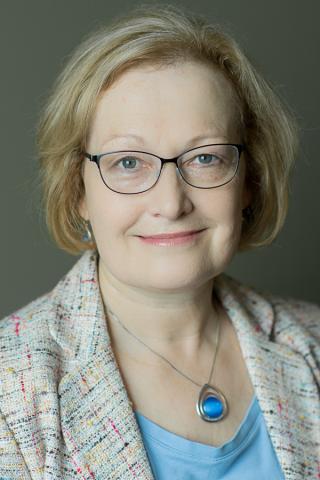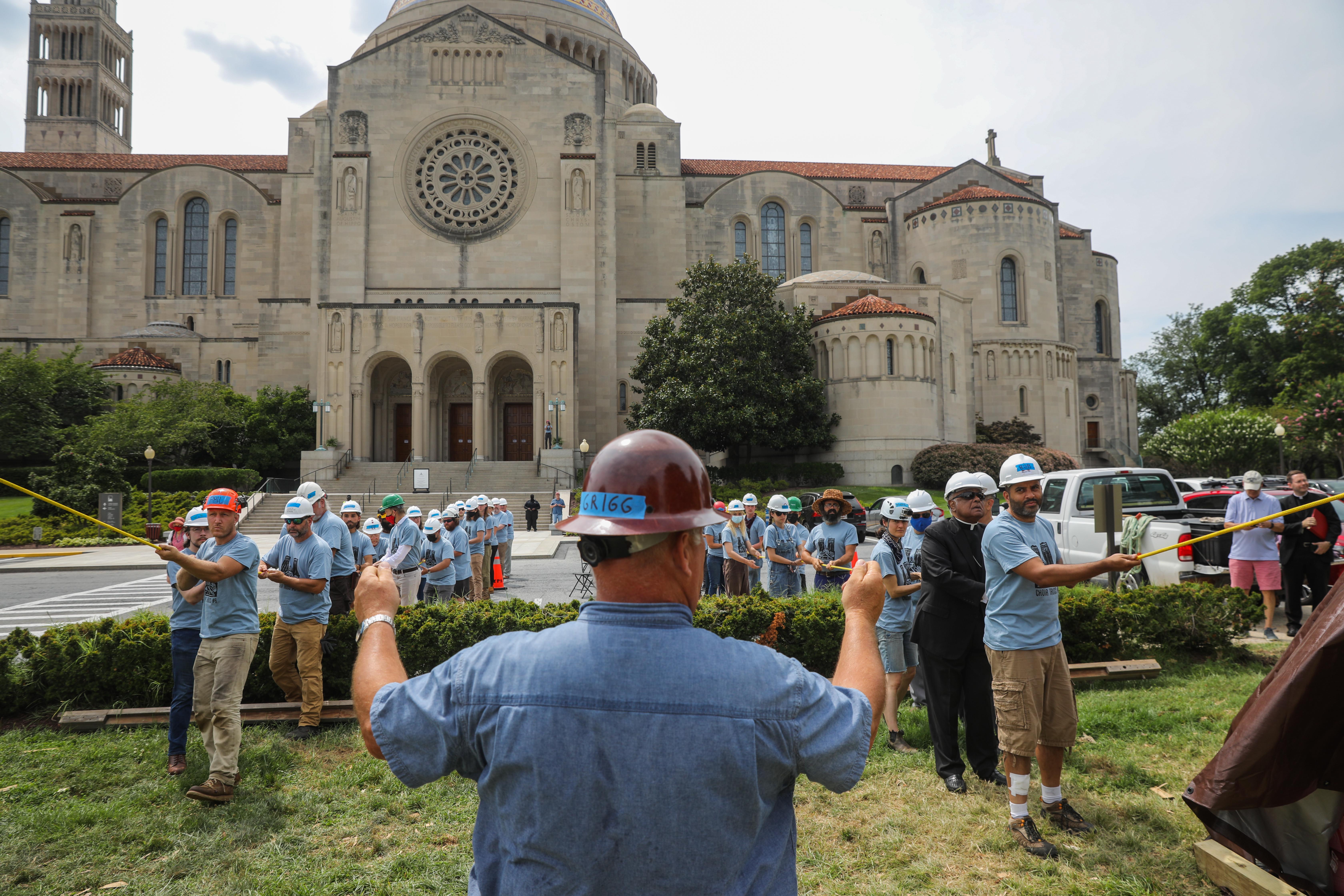The world watched in shock in April 2019 as flames devoured Notre Dame Cathedral in Paris. Eventually, burned roof sections collapsed in the French Gothic landmark that was finally completed in 1345 after nearly 200 years of construction.
A little over two years later, in the shadow of a landmark Catholic shrine in Washington, D.C., teams of architects, carpenters, artisans and students – and one cardinal-archbishop – slowly, gently pulled on rope lines to raise a painstakingly crafted roof truss that may help guide the builders who will replace Notre Dame’s roof. The Basilica of the National Shrine of the Immaculate Conception, the largest Catholic church in the United States, was a filmmaker’s dream backdrop to the proceedings.


The event Aug. 3 on the grassy mall of the Catholic University of America was part of a collaboration to research, model and build a historically accurate full-scale version of Truss #6 from Notre Dame. After months of preparation, the campus played host for two weeks as a 75-person crew took logs hauled in from the mountains of Virginia, cut them into timbers and assembled the truss using tools and techniques employed nearly a millennium ago.
The project was modeled after a similar effort by the organization Charpentiers sans Frontière, or Carpenters Without Borders, who built a version of Truss #7 in 2020 to demonstrate that the traditional methods of carpentry are possible today as the cathedral is rebuilt. There were 25 primary trusses holding up the main section of the cathedral’s roof.
Cardinal Wilton Gregory, the archbishop of Washington and CUA’s chancellor, wore a hardhat as he joined the raising ceremony at Catholic University, first blessing the crew and then lining up with them to help hoist the 35-foot-high truss into its upright position on the lawn. During a brief program afterwards, Cardinal Gregory offered his gratitude to the people who came from across the country to volunteer on the project. In his prayer, he asked the gathered crowd to focus not just on the burned structure in Paris, but to remember the people “who make up the living church.”


The completed truss was to be disassembled, trucked across town and raised in public a second time on the National Mall on Aug. 5. It will then be placed in the National Building Museum for display for at least several weeks.
Marie Brown was among those who watched the fire in 2019, stunned. Before the flames were even extinguished, she was on the phone, strategizing about how to help rebuild it with others connected to the organization she leads as the executive director of Handshouse Studio. The Massachusetts-based educational nonprofit that organized the project at Catholic University leads “adventurous hands-on projects… as a way to illuminate history, understand science and perpetuate the arts,” as its website describes its mission.

Over the next two years, Handshouse founders Rick and Laura Brown, Marie Brown’s parents, and its board members, volunteers and friends pulled together the project. As Rick Brown described the progression at the Catholic University event, the steps involved working with the university’s architecture department and other parts of the staff, such as the facilities team; the National Building Museum; the National Park Service; Carpenters Without Borders, which had the connections for Handshouse to obtain original design drawings of the trusses; the Historic Preservation Training Center; Preservation Maryland; the North Bennet Street School in Massachusetts, a traditional crafts and artisan training school; and with Maison Luquet of Alsace, France, a traditional metal forger.

At Catholic University, Tonya Ohnstad, a visiting assistant professor and interim associate dean for graduate students in the School of Architecture and Planning, took the lead with 14 architecture students who worked on the truss as a class. “After a year of online classes, this was a way to get their hands back into making something,” she said. Their work earlier in the course included researching the history of Notre Dame’s construction and building scale models of the truss.
One student, senior Michael Matthews, said after working on the small-scale models in the architecture school’s wood shop, he was happy to get involved in the tougher physical labor of using an ax to chop logs into the assorted pieces needed. “The first two days I was exhausted,” he said. “My back hurt.” To be fair, Matthews is a bit older than typical undergraduates, having spent 20 years in the Army before enrolling in Catholic University, he explained.

Rob Duarte, a board member of Handshouse and associate professor of art at Florida State University, explained that the project went far beyond simply recreating a historical piece of architecture for the sake of recreating it. As an artist, understanding the how and why of the techniques used to build the cathedral trusses “tells us a lot about how it was originally built, the history of architecture, about medieval architecture and specifically roofs.”
For instance, he learned that traditional woodcrafters hundreds of years ago would cut their logs during certain phases of the moon specifically to account for levels of sap content that varied depending upon the moon’s phase.
The quest for accuracy in the project in Washington meant that down to the smallest detail, traditional techniques were followed, including that timbers were split on-site using tools and methods that would have been employed by carpenters 700 or 800 years ago.
Duarte said some of the skilled craftspeople taught techniques for hewing and cleaving logs that originated with ancient Norwegian builders.

Marie Brown told the Catholic Standard that “there is a debate ongoing in France as to whether to rebuild Notre Dame as it once was.” Part of the problem with using historical methods, she said, is that “not enough people know how.”
As with the parallel project in France last year, the truss construction demonstration could provide the rebuilders in Paris with a model for how to use medieval techniques, Brown said. “We would be honored if that was the case.”
Brown watched the final preparations to raise the truss, a happy look on her face. At least as much as the successful completion of the truss, Brown said she was “blown away by the students and their skills, and I’m thrilled by the diversity of age, skill, expertise and demographics here.”
One final tradition wrapped up the truss raising program. The youngest person on the worksite, 20-year-old Nevan Carling, strapped on climbing gear and climbed to the top, carrying a sprig of cedar of Lebanon that he stuck in the peak. Carling, a preservation architecture student at the University of York, England, told the Standard that he was honored to carry out the traditional ritual.








